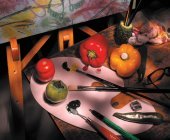|
How to Measure LightHere are some tips on how to measure light with an exposure meter. As we know that an exposure meter can take incident light reading or reflected light reading, here are steps of how to measure and check the intensity of light and contrast of an image.
When the image we are shooting is evenly lit as on an overcast or a foggy day, the range of brightness is limited. There is no spectacular high light or no dark and dense shadow area in the frame or composition. In this kind of situation, we can take reflected light reading, and one stop over or under exposed photograph also will give fairly good result, however, this choice is subjective, and depends on personal taste. To measure reflected light, point the meter (or the camera lens) at the subject or scene, we are shooting, and take readings. The exposure meter will measure brightness of light, which is reflecting back from the subject.
So in such conditions, we can take reflected light reading form the brightest spot and darkest spot in the subject. Average of these both readings will give fairly accurate result, but we have to consider the importance of bright or dark area in the subject and either over expose or under expose the photograph accordingly. In order to take selective readings from bright and dark area, we have to go close to that particular spot. If this approach is not convenient, then we can use a spot exposure meter to take readings. Spot meter can take readings from a spot from the subject, which can be as narrow as one degree. Point the meter towards the selected area and take reading. Now let us read about how to measure light on incident mode. When we take reflected light reading, the light meter reads the amount of light being reflected from the subject. In incident light reading mode, the meter measures the light, that is falling on a subject. This reading is reliable, as the meter is not concerned about the reflective nature of the surface of the subject. For this, we have to point the meter towards the source of light. The sensor of the meter is covered with a translucent plastic cover. This cover is calibrated to measure direct light falling on it. Or, we can use 18% grey card for measuring light. This grey card is readily available in the market. Place the card in front of the meter and take a reflected light reading from the card. Here, we can use the camera's built in exposure meter to measure the intensity of the light. Depending on the model, an exposure meter either directly show aperture-shutter speed combination or it will show exposure value (EV) number. Be sure to set the ISO of the meter, at the same value of camera's ISO setting. Also read about: How to use a flash meter to measure studio flash light How to measure light
|






